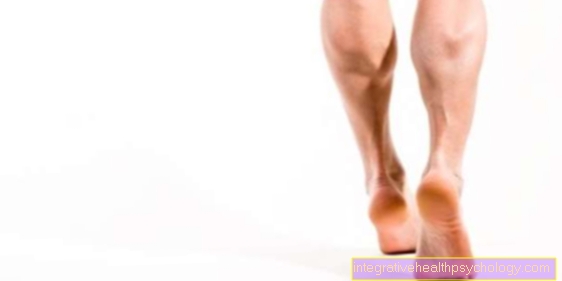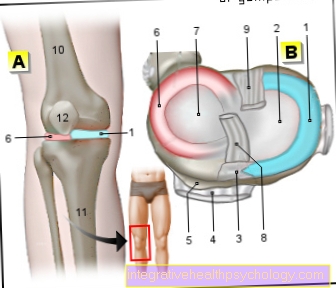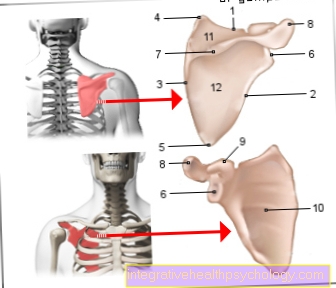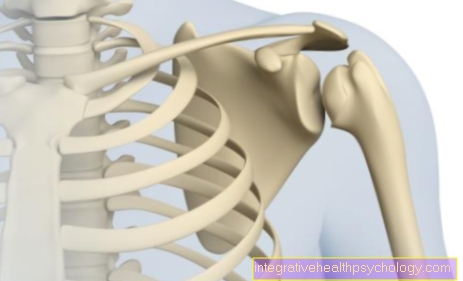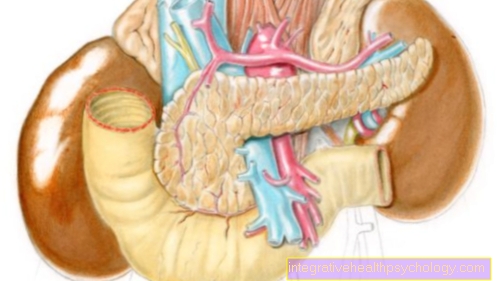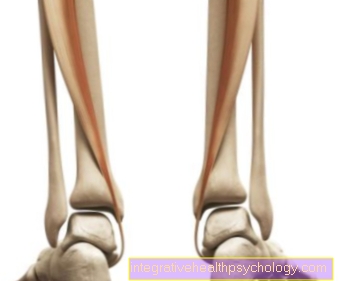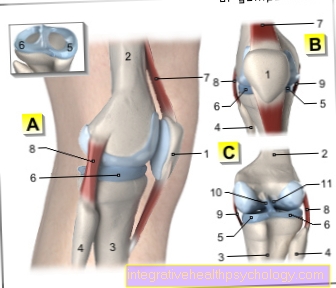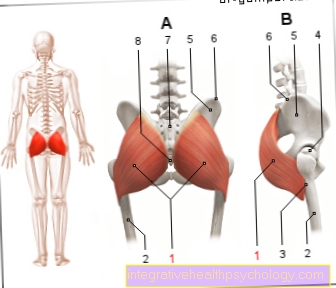Abdominal muscle training after pregnancy
definition
During pregnancy, a woman's belly increases in size from week to week. The tissue, the skin and also the muscles have to adapt to this new situation and expand beyond the normal range.
After delivery, however, the tissue, skin and muscles are still stretched. This is where postnatal gymnastics begins for every woman, which also includes abdominal muscle training with the aim of tightening the skin, tissue and muscles.
Read more on the topic Lose weight after pregnancy

Exercises
At the beginning of postnatal gymnastics, you should choose a gentle start. Relaxation exercises, yoga and Pilates offer a perfect opportunity for this.
Read more on this topic: Exercise after giving birth
Some exercises are described below:
- One of these exercises is the Buddha seat, in which you sit cross-legged upright on a sleeping mat, blanket or other soft surface.
Alternatively, you can just sit or lie down on the floor if sitting cross-legged is not yet possible.
Now you close your eyes, turn on some quiet relaxation music and consciously breathe deeply in and out. Now you can try to control the pelvic floor from the inside. This can be achieved by imagining that you are sitting on the toilet and repeatedly interrupting the stream of urine.
In order to support the exercise through breathing, it is advisable to exhale while tensing and inhale while relaxing. - Another exercise to strengthen the pelvic floor is to press the ischial bone on a chair. For this you should choose a sturdy chair.
The legs should be slightly open and the hands reach under the buttocks on the left and right so that you touch the ischial bones with both hands. Now push the bones into the chair or the palms of the hands. This tenses the pelvic floor and you automatically sit upright. The tension and relaxation should be repeated alternately six to ten times. - The hunchback is another exercise that can also be done at home. This exercise strengthens the entire core, but especially the abdomen and lower back.
The starting position is the quadruped position with a straight spine. The head is an extension of the spine and the lower legs and hands are supported on the floor.
Now you begin to walk into a slightly hollow back, with your head straightened so that you look forward.
This position is held for a few seconds before reversing the movement and turning into a cat's back. The navel is pulled up and the head moves down between the arms. This position is also held for a few seconds.
During this exercise you should make sure that the core muscles are tight and that you repeat the exercise a few times. - The air painter is a nice exercise for the entire abdominal muscles. Not only the straight, but also the oblique and transverse abdominal muscles are trained and strengthened.
However, you should not do this exercise immediately after giving birth, but start with simpler exercises first.
The starting position is the supine position with the arms on the side of the body. The legs are lifted vertically above the hips and the head is also on the floor. A fitness or yoga mat is recommended as a surface.
Now you start to circle your legs or move them up and down. The larger you draw the circles, the greater the stimulus on the muscles.
By lowering your legs to the left and right, you train the muscles on the sides to a greater extent. The legs can also be spread apart or moved up and down in alternating movements.
Read more on the subject below Postnatal exercises, diastasis rectus exercises
Tips for the Bach muscle training
In order for the regression to be successful, you should follow a few tips.
First you should be aware that every body works differently and that you should not take other mothers or celebrities as role models.
Famous mothers in particular can afford the best personal trainers and also individual ones Training and nutrition plans let create.
One should be enough time take, listen to your body and only do what is good for you. Above all, you shouldn't put yourself under pressure.
Patience and discipline are also part of successful regression training.
Already with half an hour a day you can achieve good results relatively quickly.
There are also many other exercises that you can even involve your baby in so that you can train here in a relaxed and stress-free manner.
When breastfeeding, it is also very important not to lose weight too quickly and too much. If you lose more than half a kilo per week, you run the risk that your child will not get enough nutrients from breast milk.
Furthermore you should getting enough exercise and eating right respect, think highly of. Care should be taken to eat wholesome, healthy food. This includes whole grain products like cereal, trail mix, fruits and lots of vegetables.
After consultation with the doctor and midwife you can then start exercising slowly.
But don't overdo it and focus on the first Regression of the pelvic floor focus. Gradually, the exercises can increase in difficulty and also Stomach, back and legs to include.
In addition to the slow build-up of the training, you can also small breaks not to be forgotten for recreation.Since the nights will be short, you should use small time windows to relax.
Midwives always have great ideas when it comes to small aids that should make everyday life easier. This can be a homeopathic remedy or a freshening spray in case the night has been very short again.
If the weather and health permit, it is advisable to spend a lot of time in the fresh air. You can meet up with other mothers and go for walks together, exchange ideas and start doing sports together. Because: Together, the motivation and the fun is much greater than alone.
When can the abdominal muscle training begin?
It is very difficult to determine the exact point in time from when you can start exercising your abdominal muscles after giving birth and can never be made binding. When to start training depends very much on the mother's fitness level.
In general, you should always discuss with your doctor when and to what extent you can start training.
It is also important how fit the mother stayed during the pregnancy. The physical activities in everyday life and before pregnancy also have an influence on the point in time when you can start again with abdominal muscle training.
Above all, mothers who have not done any sport before or have completely refrained from doing sport during pregnancy should start training slowly immediately after pregnancy and attend a course on postnatal gymnastics first.
Mothers who have remained active in sports can begin with light stretching exercises after giving birth.
also read
- Tight belly after pregnancy
- Abs workouts during pregnancy
Risks
Anyone who had back pain or pelvic pain during pregnancy should first ask their doctor whether and from when abdominal muscle training and sport in general are possible again.
If the abdominal muscle training is started too early or the training is made too intense, risks can arise and also intensify.
During pregnancy, the ligaments and abdominal muscles are stretched and pushed to the side by the growing uterus. This process is called Diastasis recti.
Diastasis recti can cause pain in the lumbar vertebrae and lower back during and after pregnancy.
Read more at: Diastasis recti exercises
Mothers who start abdominal training too soon after giving birth run the risk of a so-called pointed belly. The muscles need time to move back to their place of origin after birth.
If you intervene too early with abdominal muscle training, it damages the muscles more than it strengthens them. The muscles no longer retreat to their place of origin, but run obliquely forward. If the abdominal muscles are now contracted, the abdomen arches forward through the abdominal muscles lying on the sides.
You can read more helpful information on the subject: What postnatal courses are there?



